The business section of last Sunday's New York Times had a long article about a Swedish company that is solving its affordable housing need by building modular homes - factory units that are cheap to build and easy to erect. The article said U.S. companies are starting to pick up on the idea as a way of providing the low cost housing that is in such short supply. The problem is serious in South Florida where so many rich people need poor people, often immigrants, legal or non, to maintain them. Alas the poor people can't afford to live anywhere near that work. Thus a shortage of affordable housing.
The Times piece mentioned some U.S. companies entering the modular field, along with some past efforts that for various reasons did not work. We only read the article because it relates to our family's history in a sad way. To our surprise, for a paper that is usually thorough about such history, there was no mention of the largest pre-fab failure of them all; one involving what was once the most powerful retailer in the nation. From early in the 20th century Sears, known as Sears, Roebuck at the time, had a pre-fab housing business that produced 75,000 houses, many of which are still standing and have become something of tourist attractions.
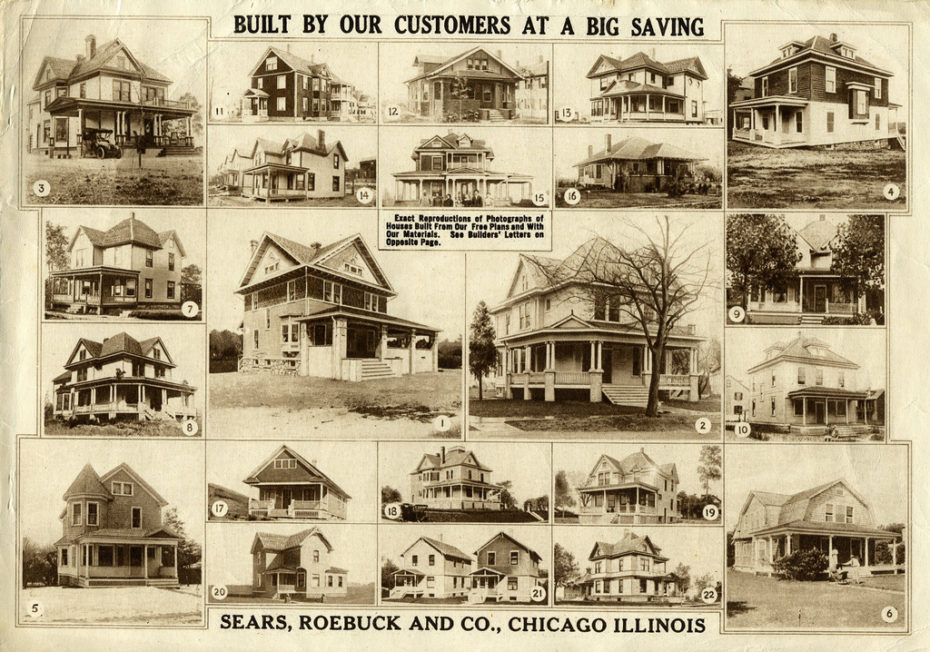
Sears ads showed a variety of homes.
That's where it hits home. Philadelphia was a major Sears employer. Most families in our old neighborhood had someone working for Sears. That's where many couples met, including our parents. Dad went to work in the early 1920s and spent most of the next 21 years in the pre-fab division. He specialized in plumbing and heating, which was one of the big attractions of the program. Depending on how much they wanted to spend, buyers could have a house shipped to a location ready to occupy. Buyers had to put the parts together. Some handy people did it alone, although most had neighbors' help. In a few days, a house would appear.
Sears offered a variety of designs, under a banner of "Modern Homes," from very basic structures to elaborate houses that still look good today. But what had been a thriving business took a downtown in the Great Depression. In order to make it easier to sell houses, Sears had entered the mortgage business, and the depression resulted in many defaulted loans. Sears, with classic bad timing, in the early 1930s moved its Modern Homes unit from Philadelphia to a bigger facility in Port Newark, New Jersey. Dad commuted for several years then moved our young family to North Jersey. He was just in time to see the weakened economy catch up with Sears. Facing big losses, Sears closed the Port Newark operation in 1940. Dad managed a transfer to Elmira, New York, where he managed plumbing and heating in the local store. My mom was never happy away from Philadelphia, and in early 1942, we moved back to Philadelphia. Again just in time for Sears, anticipating a loss of business as we entered World War Two, decided to lay off a bunch of middle management personnel. After 21 years of faithful service, my dad was out of work.
It is difficult to overstate the trauma for a 46-year-old man with three young sons. Dad struggled for a time, then found work in the insurance business. He wasn't cut out for that field. He did not like to gladhand or sell to relatives and friends, but he managed to survive, thanks to the protection of a union. He was always struggling with debt until we got out on our own. But getting canned by Sears permanently scarred him. Before that event, photos showed a confident, almost cocky man. Afterward, he appeared dignified but resigned to having wasted the best years of his life.
A final irony to this story. In hindsight, it appears Sears left the housing business at a very time when it could have been saved. The war produced an urgent demand for new military facilities, hundreds of barracks, and other structures needed for training. Given its experience, those buildings would have been child's play for Sears to produce, and they could be installed by army engineers. By the end of the war. it should have recovered from its pre-war mortgage disaster and be poised to fill the demand for housing from thousands of returning vets starting families.
We wish those companies today entering the modular home field well. Mostly we wish them the one quality that all businesses need. Timing.
If you ignore the God-awful Manhattanizing of downtown Fort Lauderdale, in which he and all other elected officials share discredit, Fort Lauderdale Mayor Dean Trantalis is looking pretty good in there lately.
He has stepped up in the debate over whether a bridge or a tunnel should be built to end the bottleneck where the FEC Railway tracks now cross the New River on an ancient lift bridge. It disrupts busy river traffic which will only get worse as the Brightline expands and other passenger trains are introduced - something that is already happening. Trantalis favors a tunnel and has proposed a shorter, much less expensive design.
Broward County has favored the bridge, which would be enormously disruptive, and as Trantalis has pointed out, be far more expensive than published estimates, which don't include land costs and other construction such as rebuilding the elaborate new Brightline station. Nor does it consider the impact of a high bridge soaring through downtown, impacting new high rises being built near the tracks. The tunnel in contrast will cause little disruption.
More recently Trantalis has taken a position on the very controversial proposal to rebuild La Olas Blvd. in the heart of the business district, which includes removing the median which endows the section with its uniquely welcoming atmosphere.
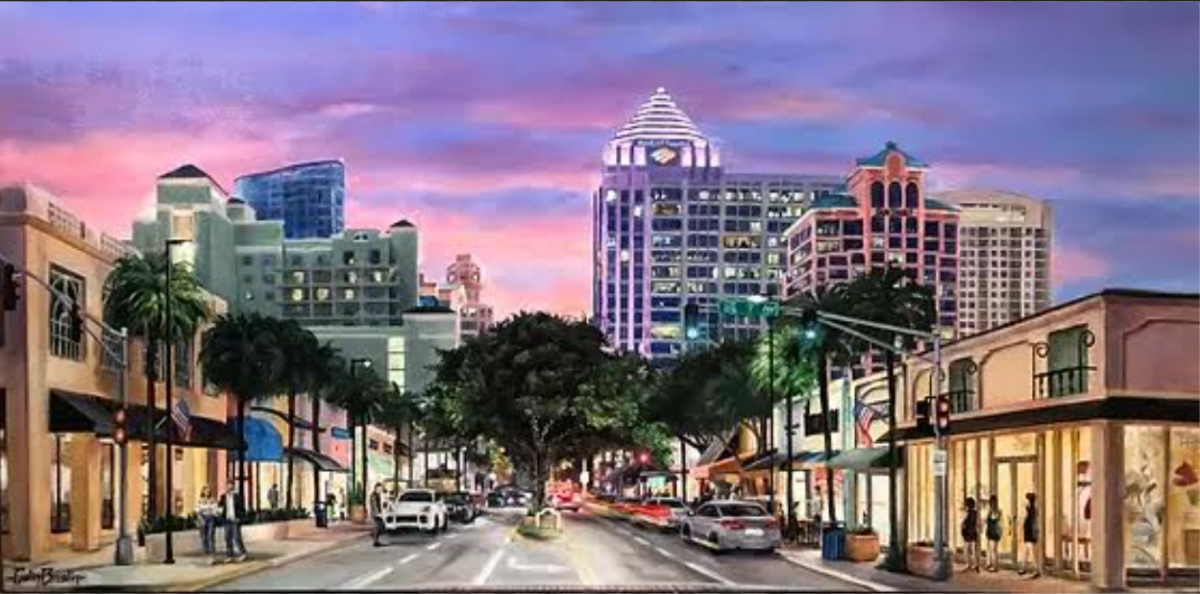
This painting of Las Olas looking west was done by recent Florida State grad Colin Breslin, no connection to the writer except his grandson.
A little history here for the business community which is pushing for such a dramatic rebuild. Las Olas, of course, is the oldest street in the area. On it sits the first structure, the Stranahan House, now a historic site. The street was also home to the original St. Anthony Church, which likely drew more traffic than any other early structure.
The boulevard evolved slowly. Its modern character began when the elegant Riverside Hotel opened in 1936. A few years later Maus & Hoffman led a movement of fine shops from Northern Michigan to South Florida, most following the men's store to Las Olas, or near it. These events gave Las Olas its commercial character, but the street closed down after dark.
There was no good restaurant until William Maus backed Louis Flematti in opening Le Cafe de Paris in 1962.
Other restaurants came and went over the years, but it wasn't until the late 60s that the median was installed. At the same time, Wells Squier redesigned the heart of the street, with charming facades which make ground floor structures appear bigger, but there was little nightlife or entertainment. The Riverside Hotel had a dark room where the new Maus & Hoffman store now sits which featured good talent on weekends, but the nightlife we know today was still years down the road. Until fairly recent years, Commercial Boulevard, far to the north, was the place to frolic after hours.
That gradually changed during the 1980s. A big step toward the Las Olas we know today came in the late 1980s. Kitty Ryan opened O'Hara's Jazz Club next to the Riverside. It became very popular on weekends and was a hangout for press people, back when there were enough of them to justify a hangout. Its popularity led Ryan to convince the city to allow sidewalk tables. O'Hara's closed to make room for the Riverside Hotel expansion, but by then, other establishments, including the Riverside, were busy with outdoor dining. The whole movement would likely not have been possible without the shaded median that added greatly to the outdoor ambiance, by slowing traffic on the ever-busier boulevard, and made crossing from one side to the other an easy and safe process on new crosswalks.
In 2024, the nightlife has spread west with some good restaurants snuggled under the new office buildings, and traffic in the primary shopping blocks has steadily increased so that sidewalks, with tables, are often overcrowded and creating a safety problem.
From published comments and word of mouth, most residents think removing the median is a bad idea. They think it has much to do with the popularity of the boulevard. Fortunately, so does Mayor Trantalis.
The proposal to eliminate the median points out that the landscaping trees will not last much longer, and instead of replacing them, calls for widening the sidewalks and landscaping them with oak trees. Sounds nice, but will it retain the charm of the median, and will traffic speed increase without the divider, thereby negating the goal of improving pedestrian safety?
Mayor Trantalis has posed a creative solution. Noting that sidewalks on the north side of Las Olas are smaller than the south, he suggests widening only that side to relieve the more serious pedestrian congestion.
There are legitimate opinions on both sides of this issue. The opinion here is that it is risky to change what obviously works, for something that may not.
The death of Bob Graham has brought an avalanche of accolades for the kind of political leader they don't make anymore - at least in Florida. We could not help but relate Graham’s passing with circumstances surrounding our first exposure to the man.
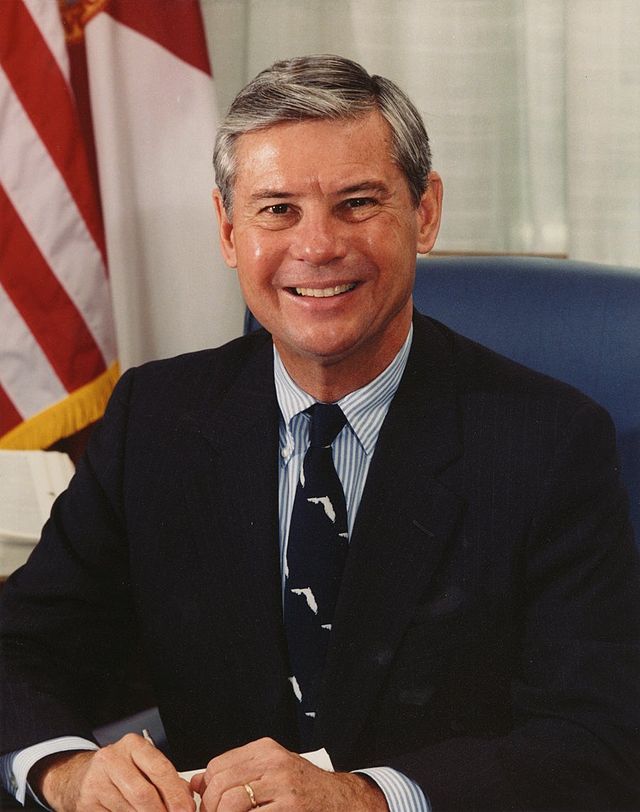
Bob Graham, 2001
That was in 1974. We were new to Gold Coast Magazine and slowly adding the types of coverage that the magazine lacked. We did sports when Le Club International sponsored a car in the Grand Prix of Monaco, and then we covered the Miami Dolphins when under new coach Don Shula they gave promise of future success. We did not know much about Florida government except that Claude Kirk had attracted national attention as a flamboyant, often outrageous governor. He had been followed by Reuben Askew, whose notions of good government departed from most of Florida's past. He had a reform coalition composed of men from both political parties.
That first visit to the capital was aided by Broward Countians Ed Trombetta, a Democrat, and Van Poole, a Republican. We did not know it, but we crashed a historic event - the modernization of Florida government with the Government in Sunshine movement. It was led by a relatively young group of legislators including Republicans Joel Gustafson and George Caldwell from Broward and Don Reed from Palm Beach. They joined outstanding representatives from Miami, including Bob Graham.
The standout in that group, however, was not Graham. That distinction belonged to Marshall Harris from Miami. He was called "the Jewish William Buckley." He was Harvard undergrad and law, and he had a patrician bearing and eloquent style like Buckley. And like Buckley, he could be arrogant, but his intellect and hard work made him an admired figure by both parties. He had been named "legislator of the year" three times in the years before we met..
The late Joel Gustafson described Harris at the time.
"He's one of the brightest people I’ve ever worked with. Fiscally, he's very conservative, really tough on the budget. He could almost run as a Republican. Nobody was quicker to take the various departments to task over how they spend their money."
He added thoughts when Harris died in 2009. He had seen him only a few times since both departed Tallahassee. In fact, our phone call was the first time he learned of Harris’ death.
"When I had some issue I wish I could have talked to him. He always worked on it. There was a bond in the people who showed up in those days. We were like a big fraternity."
Can you imagine a prominent GOP legislator describing a Democrat in such terms today?
Unlike Harris, who retired from public life, and whose death was little noted, Bob Graham went on to serve as governor and U.S. senator. Upon his death, we regret that the good work he and men like him and Marshall Harris did in Tallahassee is now being taken apart piece by piece by Governor Ron DeSantis and his lackeys. The last thing they want is the open government in the sunshine so hard won by men like Bob Graham years ago.
"Masters of the Air," the docudrama recalling the remarkable story of the first heavy bomber units to attack the Germans in World War Two, has saluted the pilots and their planes which took terrible losses before ultimately prevailing over the Luftwaffe's formidable defenses. The series, which ends this week, has been extensively promoted on the internet and has generated interest in the airplanes involved. Most prominent are the Boeing B-17 bomber, nicknamed the Flying Fortress, which pioneered dangerous daylight bombing in 1943, and the North American P-51 Mustang, the fighter which was vital in neutralizing the German fighter planes in 1944 and 1945.
Those two aircrafts, oddly enough, both touched our former magazine, Gold Coast, in curious ways. Covering these tales chronologically, we go back to the 1970s. The P-51 had been preserved in larger numbers than most warbirds, serving for years with several foreign air forces. It also enjoyed a second career as an air racer. A prime example of the Mustang was based in Broward County, owned and raced by a notorious character named Ken Burnstine. Burnstine was an Ivy League-educated developer and accomplished pilot who owned and raced a colorfully painted P-51. He was the essence of flamboyance in his personal life. He gloried in publicity of any kind. Among other attention-getting activities he kept a pet lion in his Coral Ridge home. He also had developed a second career as a drug runner. Planes he owned crashed loaded with dope flown in from the islands and Central America. He always claimed the aircrafts were leased and he had nothing to do with drug running. Nobody believed him, including the police, and people wondered why he was not arrested.
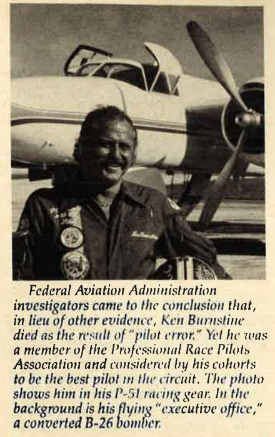
Our magazine helped spread his legend when we featured his P-51 on our cover in 1975 during a general fuel shortage. Margaret Walker, our veteran associate editor, was appalled that we would feature such an unsavory character in a magazine which still was identified with social coverage of people dancing for disease. But the story got a lot of interest, for many of our readers knew Burnstine. But they did not know him long. In 1976, he died when his air racer crashed while practicing for a race in California. The plane burned out and a common reaction was "Oh, that beautiful airplane." Such was Burnstine's reputation that over the next few years, rumors spread that he had faked his death to avoid prosecution for drug running. It was reported that only a thumb was found in the crash and that he had been spotted living the good life in Europe.
At the time, Burnstine had been arrested but was avoiding prosecution by working as an informant for the feds. It was suspected he was running guns south for our government to support covert activities in various countries. In return, he was allowed to keep his drug-running operation on the trip home. That cozy arrangement was about to end, however, for Burnstine had implicated a number of local people, some prominent, in funding his drug operation. The government was about to move when their star witness died in the crash.
All this intrigued Gaeton Fonzi, our partner who had an instinct for stories behind the story. In 1981, he contacted California authorities and learned they were puzzled by all the rumors of Burnstine surviving the crash. His whole body was found in the wreckage, not just a thumb. Fonzi also learned that people at the airfield where he died found the circumstances of the crash suspicious. Burnstine was known to indulge his show-off tendencies upon takeoff by rolling his plane as soon as he gained enough altitude. When he did so that day, he cried out suddenly and his plane plunged out of control into the ground. Observers thought something happened in the cockpit to cause him to lose control. One theory was that a motion-activated bomb went off as soon as he started his maneuver. That bomb would burn out and leave no trace behind. His plane had been untended the night before and someone could have planted the bomb without being seen. In short, Fonzi concluded, he might have been murdered. There were certainly enough people who would want him dead before he could testify against them. At the least, Fonzi put to bed the nonsense about Burnstine living the good life in Europe.

Gaeton Fonzi's investigation led to a three-part series in 1981. It was one of the best-read stories in the magazine's history.
Our encounter with the B-17 came much later. In 2005, we got an invitation to take a press ride on a touring B-17. We accepted, of course, and took a brief (about 10 minutes) hop from Stuart to Vero Beach. We got to tour the plane. Our best memory is before takeoff we sat near the tail and watched Ernest "Mac" McCauley operate the tail wheel manually. A young woman was at the controls that day and McCauley seemed disturbed. "That girl will wreck this plane," he muttered. McCauley himself was the usual pilot, and with years on the job, was called the most experienced B-17 jockey in the world. It is beyond irony therefore that in 2019 the same plane crashed during a demonstration at Bradley International Airport in Connecticut. An engine failed on takeoff, and the plane did not make the runway when trying to return. Seven of 13 aboard died in a crash landing, including the pilot. An investigation blamed pilot error for the tragedy. The plane lost speed on its landing approach because the wheels were lowered too soon and created drag. The pilot was Mac McCauley, the most experienced B-17 pilot in the world.

The magazine did several stories on wealthy owners of vintage planes. Eight-year-old Mark McCormick and his father Bernard posed with this P-51 in Miami in 1974.
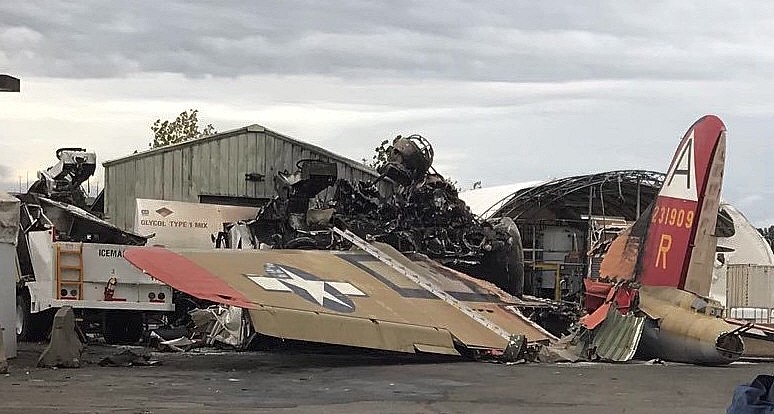
The remains of the B-17 the author flew in 13 years before this crash in Connecticut.
The debate over whether a tunnel or bridge should carry the busy FEC rail tracks through downtown Fort Lauderdale is slowly getting the kind of information needed to make a sound decision. A tunnel would obviously be the choice were it not for the consultant’s estimate that it would cost six times more than a long tall bridge across the heart of the city.
The need for a solution is indisputable. Future plans would put 200 trains a day on the FEC tracks. The interruption of marine traffic would be intolerable to that important industry. The existing lift bridge would be perpetually closed for trains.
Initial reports were based on a tunnel and bridge both more than three miles long. That seems long for either project, but especially the tunnel – if it were limited to passenger trains that can handle relatively steep grades. More recently, the idea of a much shorter and cheaper tunnel has popped up.
And why not? In all the reporting in the media, nowhere did we see the obvious guide for evaluating those options. There is a tunnel just a few blocks east of the rail line which has handled vehicular traffic for years, and a more recent rail bridge on the CSX tracks to the west along I-95.
The Henry Kinney Tunnel is a mere .3 of a mile. But the underground portion is only about .2 of a mile, about a long city block. A modern passenger train such as Brightline can easily handle that grade on a structure whose roof is 14 feet below the river level.
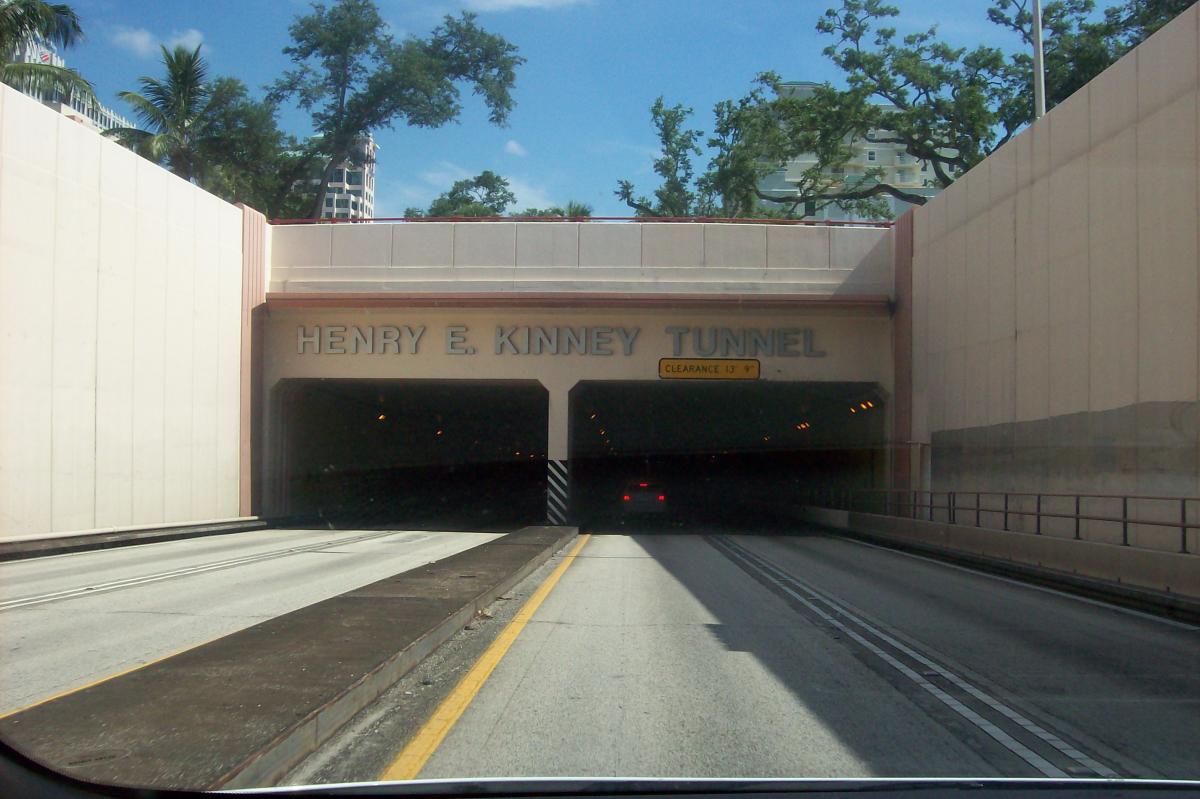
The Henry E. Kinney Tunnel
We know that because the CSX bridge to the west, which is 1.7 miles, rises high above the river, and Tri-Rail and Amtrak trains handle that grade with no problems. The downtown bridge would be at least that high, about four stories, and would necessarily need more approach length than a tunnel. Its impact on the fast building downtown would be far worse than the tunnel. It would have to be built over the existing FEC tracks, hard by existing high rises and new ones underway on both sides of the river.
It would also compound existing traffic problems by closing off some busy streets. And to the south, it would rise above the city’s historic old neighborhood where the earliest structures have been preserved, largely destroying their legacy attraction.
Were these hidden impacts considered in the cost estimates? And what about the elaborate Brightline station? The bridge would be near its highest point at that location. Imagine the cost of adapting a station designed for ground-level tracks to handle trains four stories high. It would likely have to be rebuilt elsewhere, negating its present convenience at busy Broward Blvd.
Without engineering or accounting expertise, it seems to this observer that the cost of these two proposals needs serious reevaluation. From their published comments it appears the city commissioners don’t have a real fix on the comparative costs. Fortunately, Fort Lauderdale Mayor Dean Trantalis, a strong advocate for a tunnel, has made most of the points mentioned here. We hope the other city commissioners are listening.
David Talbot, whose book “Brothers” remains an authoritative analysis of the Kennedy brothers assassinations, recently wrote that although 65 percent of Americans are convinced that JKF’s death was some sort of conspiracy likely involving our own government, major elements of the press still accept the Warren Commission’s conclusion that Lee Harvey Oswald was the lone assassin.
Talbot traces the indifference of the press back to the original Warren Commission in the 1960s. Its findings were not only accepted but praised by important newspapers. The bylines were people who had barely glanced at the 26 volumes and, in some cases hadn’t read them at all. The handful of people who actually read them quickly began exposing the obvious strained explanations for a lone assassin. Those people were branded kooky conspiracy nuts, but over the years dozens of researchers have reinforced their doubts and gradually convinced the public that we never got the truth of both Kennedy murders.
We saw the press failures up close from the beginning. Extensively briefed by Vince Salandria, a Philadelphia lawyer who had actually read the report, Philadelphia Magazine’s Gaeton Fonzi confronted Arlen Specter, the man who invented the “magic bullet” theory. Specter, who had been basking in the praise for his work, did not expect Fonzi to be so prepared, and he made a fool of himself trying to explain what could not be explained.
This was dramatic stuff but was totally ignored by the Philadelphia media. It was, however, not ignored by Richard Schweiker, who 10 years later was a U.S. Senator, and hired Fonzi as an investigator for the House Select Committee on Assassinations. Fonzi, who by then was a partner in our Gold Coast Magazine, did a great job, finding a contact between Oswald and a highly placed CIA man who headed anti-Castro efforts in Florida.
His committee head was reluctant to accept his findings, although most of the staff agreed with Fonzi, and its final report said there was a conspiracy behind JFK’s death, but only added to the intrigue by not naming the conspirators. A disappointed Fonzi wrote a book which did name names, and a lot more, some of them CIA operatives. “The Last Investigation” ran in Gold Coast Magazine and The Washingtonian, a well-read and influential publication in the nation’s capital. Amazingly, it too was ignored by Washington media, and not until Fonzi turned it into a book did it attract national interest. Today, it has joined David Talbot’s books as one of the most trusted works on the subject.
We bring this up in connection with a fresh series, “Four Died Trying” which debuted Nov. 22 on the 60th anniversary of JFK’s death. Subsequent installments (more than 20) will be one of the most intensive efforts to uncover the truth. It has been more than seven years in the making. According to director John Kirby, it will include the media’s sorry role over the years. “We address it in the prologue,” says Kirby, and we do it again and again and again.”
It will take a good many agains to make up for the media’s dismal performance over the years.
Recent Robert Kennedy Jr. inspired Assassination coverage has included a piece of trivia ridiculously overblown by uninformed writers as some kind of dramatic breakthrough in the 60-year-old case. We refer to the long pieces about an aging former Secret Service agent admitting he found the bullet in the limousine in which JFK was killed. He placed the bullet, which appeared to be pristine, on the stretcher that bore Governor John Connally’s wounded body into the Parkland Hospital where JFK was pronounced dead.
First of all, the bullet on the stretcher was known to be strange. It did not appear to have been fired. And it was obvious from the beginning that somebody put it there. Now we know the explanation for that piece of trivia. And trivia it is because it does not destroy the credibility of the Warren Commission Report. That credibility was already destroyed not long after it was published in 1965, two years after the assassination.
I wrote about the challenges to the commission, which found that Lee Harvey Oswald acted alone, when I was still a newspaper columnist in 1965. Later at Philadelphia Magazine, I watched over his shoulder as Gaeton Fonzi wrote that Arlen Specter, later a U.S. Senator, stumbled all over himself trying to explain his own “magic bullet theory” that was necessary to show Lee Harvey Oswald was the lone assassin. The Warren Commission had given Specter the impossible job of showing how Oswald could have acted alone.
By the 1970s, the Warren Commission was discredited and the CIA had become suspect in rigging it. It had been learned that Supreme Court Justice Earl Warren was just a figurehead; he had little to do with the actual report. And several of the Commission’s members-only signed the final report under pressure. They did not believe it. Further, the man who controlled the commission behind the scenes was Allen Dulles who had been head of the CIA and had been fired by JFK after the Cuban Bay of Pigs disaster. Kennedy believed the CIA knew it would be a failed invasion, and was trying to force him to involve American troops, which he refused. It appeared that Dulles continued to strongly influence the CIA even after he left. And Kennedy privately vowed to destroy the entire spy apparatus. Ironically, his death was an example of Kennedy’s concern that the CIA was a government unto itself.
It was also learned that the Warren Commission’s charge was not to determine who committed the crime, but to show how Lee Harvey Oswald acted alone. Evidence grew that the fatal shots had come not from Oswald’s alleged perch in a building behind Kennedy, but from much closer on the grassy knoll in front of the car. The numerous witnesses to that had been ignored by the Warren Commission.
By the early 1970s, doubts about the lone assassin conclusion were so widespread that a new congressional look was opened by the Church Committee, headed by Pennsylvania Senator Richard Schweiker. Schweiker, recalling Gaeton Fonzi’s work at Philadelphia Magazine, hired him as an investigator working in South Florida, seeking connections between Oswald and the CIA through anti-Castro groups. Schweiker described Oswald as “having the fingerprints of intelligence all over him.”
Schweiker was no longer involved, but he likely had a hand in picking its first director, Richard Sprague, a brilliant Philadelphia prosecutor. But Sprague was quickly forced out by conservatives on the committee when he refused to sign a secrecy agreement with the CIA. His replacement trusted the CIA, which he later regretted. He wanted to pin blame on organized crime and wasted a lot of Fonzi’s time to prove it. He questioned Fonzi’s findings that a credible anti-Castro leader saw Oswald with a top CIA man in Dallas shortly before the assassination. He also downplayed Fonzi’s assertion that known CIA operatives (Watergate burglar Frank Sturgis foremost among them) wasted his time with tantalizing tips that turned out to be bogus. Those distractions further convinced Fonzi that the CIA was involved in both the assassination and the elaborate cover-up.
The committee’s final report, much of which Fonzi wrote, did say the assassination was a conspiracy, negating the Warren Commission’s lone assassin claim. However, it did not name the conspirators or even mention Fonzi’s dramatic discovery of the CIA connection to Oswald. Fonzi (and other investigators) were greatly disappointed that years of work were being wasted. Fonzi decided to write what amounted to a dissenting opinion. It identified the CIA man seen with Oswald as David Atlee Phillips, chief of the CIA’s Western Hemisphere Operations. Fonzi’s “The Last Investigation” originally ran in a three-part series in our Gold Coast Magazine and The Washingtonian, where it resulted in a suit by Phillips against that magazine. The magazine won a costly case.
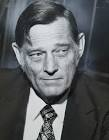
Gaeton Fonzi discovered a connection between Lee Harvey Oswald and this high-ranking CIA man, David Atlee Phillips, shortly before the assassination.
Fonzi on his own spent the next decade furthering his investigation, and in 1993 published a book that is still in print. Upon his death in 2012, it was cited by the New York Times as one of the best books on the assassination.
The recent pieces about the stretcher bullet did not mention the 1970s Congressional investigation which discredited the Warren Commission and made the bullet merely an irrelevant piece of trivia. So much for the state of coverage of one of the most important stories of our time.
******
Just as this rant was being completed there came news that a long-anticipated documentary was ready for viewing. It will appear on November 22 - the 60th anniversary of the JFK assassination. "Four Died Trying" is a reappraisal of the murders of JFK, his brother Robert, Martin Luther King, and Malcolm X. If that seems an odd coupling, the common thread is the assertion that all four of these crimes in the 1960s bore the fingerprints of the CIA or other government-related groups. Our interest, of course, is primarily the Kennedys. The prologue will be the first of what will be more than 20 installments.
The prologue does a beautiful job of explaining the motivation for the murder of what most people regarded as a popular young president. With the CIA, he was anything but - a traitor who was a threat to national security and to the existence of the CIA itself. It includes some rare film, including a young Congressman Kennedy, after a 1951 visit to what was then French Indochina, explaining that the French could not preserve their colony in the face of the Vietnamese desire for independence. This was a decade before our entrance into Vietnam. It supports claims that President Kennedy wanted to pull out of Vietnam as soon as he could safely do it politically - one of the reasons he was killed.
The team of Libby Handros (producer) and John Kirby (director) has been working on this project for seven and a half years. They interviewed more than 120 people. The producers met with me six years ago, discussing my late partner Gaeton Fonzi' s landmark work. I will likely show up in a future installment devoted to Fonzi's role.
This series should be a must-viewing for anyone wanting to pierce the fog of contradictory reporting on great events of the 1960s. The initial presentation will be streamed on Apple TV, but will then be available various platforms. Kirby says a promotional campaign reaching millions of people through social media will soon be underway. Can’t wait.
The inclination to rewrite history has resulted in the questionable, and to history buffs offensive, removal of names and monuments of important figures in our history. Men considered patriots in their times are now branded traitors, and as such are being expelled from history. The lengths to which this movement has taken are illustrated by a recent essay by James Webb, decorated Vietnam Marine and former Secretary of the Navy. Webb writes in the Wall Street Journal of the proposal to remove the monument to Confederate dead at Arlington National Cemetery, which falls under a provision tacked on to a 2121 defense bill that authorized all the statue removals and military base name changes we have seen recently. He points out that this is no ordinary monument, erected by Southerners to keep alive the memory of their state heroes and, to critics, preserve the spirit of rebellion.
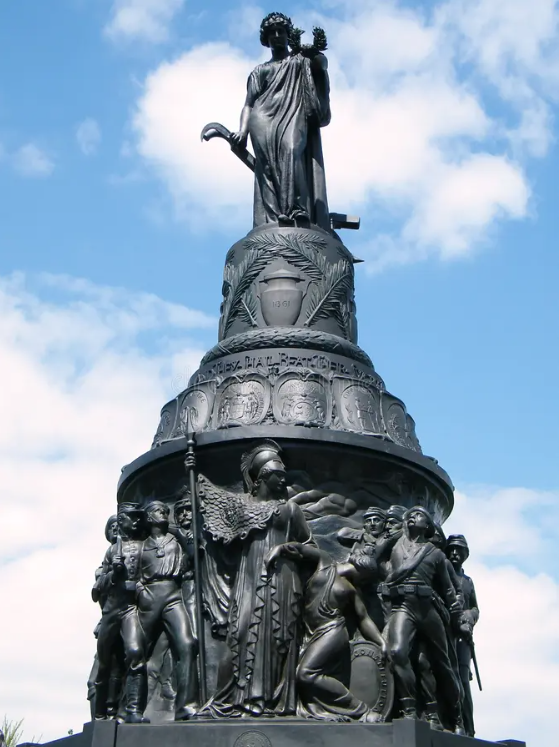
The Confederate memorial is an impressive sculpture, but some of the figures today are perceived as racist.
Quite to the contrary, this memorial was originally proposed by a U.S. president to bring the states together after the bitterness and failed reconstruction following the Civil War. President William McKinley picked both southern and northern commanders to lead our troops in Cuba in the Spanish-American war in 1898. These were men who had fought against each other in the Civil War, and McKinley wanted to take advantage of the new unity by expanding it to honor war dead from the South in a Confederate memorial at Arlington National Cemetery.
McKinley had been in the war himself with a regiment from Ohio, and like Abraham Lincoln, he bore no animosity toward the average southern fighting man in that terrible conflict. They were simply fighting for their homeland. It is often forgotten that prior to the Civil War, there was an ongoing debate about state vs. federal government primacy. Patriotism could apply to one’s state as well as a national government.
McKinley was assassinated before the memorial actually appeared more than a decade later, and he might not have been thrilled by some elements on it which did little to produce the harmony he envisioned. The principal objection to the memorial is that several figures on it depict blacks as docilely serving their white masters, preserving the concept of “the lost cause.”
A website for the cemetery puts it well: “The elaborately designed monument offers a nostalgic, mythologized vision of the Confederacy, including highly sanitized depictions of slavery.” That is not quite what President McKinley wanted, although he probably was not thinking of slavery, but rather curing the bitterness which still existed between the states.
It is true that the “lost cause” concept was still current at the time, and it still is if you consider a film such as “Gone With The Wind” which depicts blacks in a contented subservient role. But should that classic film be banned too? The fact is that it is part of history.
James Webb was raised in a military family and writes: “The larger and ultimate question reaches further into America’s atrophied understanding of the Civil War itself. What was it that Union Army veteran McKinley understood about the Confederate soldiers who opposed his infantry units on the battlefield that eludes today’s monument smashers and ad hominem destroyers of historical reputations?”
The rationale for historic revisionists, largely left-wingers, is that the Civil War was a black mark on American history, and those who started it should not be honored or even remembered. In effect, change history. By that thinking, why do we still teach about slavery, the economic/political cause of that war? It is also a black mark on our record, and should we not simply pretend it never existed? Right-wingers arise.
That has already happened in Florida where Governor Ron DeSantis wants slavery and its after-effects played down in public schools, except to note that slavery advanced some blacks, giving them skills such as blacksmiths. That’s the reason the country overflows with people who are great blacksmiths. Now we just need some horses to keep them busy.
Where is William McKinley when we need him?
We often read of neighborhood efforts to save historic buildings and landmark trees from development. Builders buy property in historic tree-shaded neighborhoods, then demolish old homes and cut down those hundred-year-old trees – the very thing that attracts them in the first place – to build huge houses out of character with their rustic surroundings. Community associations often object, but their efforts usually prove futile, “Growth over preservation” seems to be the mantra that too often guides the decisions of government officials.
Fort Lauderdale has seen more than its share of these decisions in recent years. Few of the structures built by pioneers have escaped the sprawl of development. But fortunately not all. And by far the most noteworthy is the city’s first residential house, which figured in almost every aspect of the city’s formation. It has been preserved by history-conscious citizens. Anyone familiar with Fort Lauderdale history knows we refer to the Stranahan House.
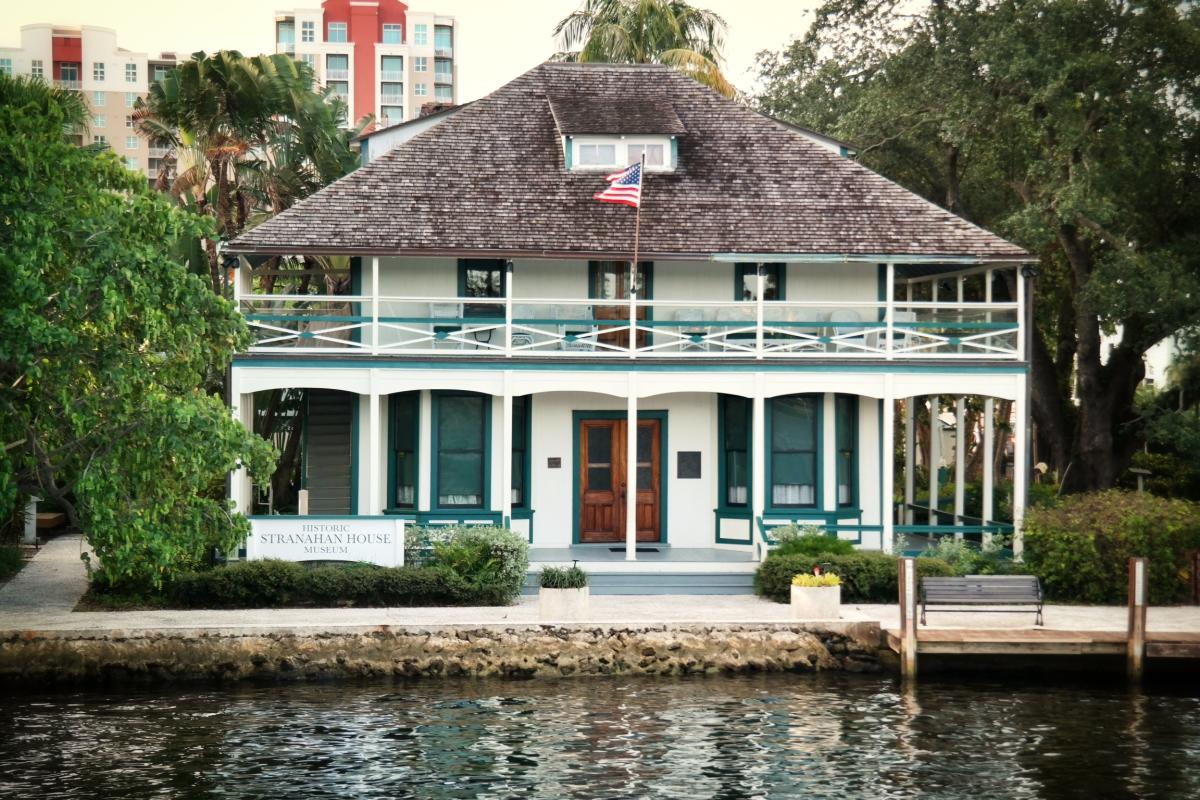
The Stranahan House is now literally a museum, supported by its own foundation. Like colonial-era buildings saved in old northern cities, it has become a tourist attraction, continuously memorializing the extraordinary family who first saw the potential of a vibrant city along the banks of the New River.
Frank Stranahan did many significant things in his life, not the least of which was marrying a young school teacher named Julia Ivy Cromartie. She arrived in Fort Lauderdale at age 18 in 1899 from Lemon City, today’s Miami. Frank had arrived six years earlier from Melbourne, Florida where he gained experience in government. He was the first pioneer to establish roots in the area, setting up a trading post and tourist camp on the New River. He ran a ferry and was involved in a stagecoach route to Miami until the railroad came through. He expanded into a general store and even a bank and post office on the site. He later moved his businesses and turned the building into his residence.
Joined by his new wife, he had a hand in virtually every aspect of the city’s development – transportation, education, medicine, urban planning, banking, and establishing cordial relations with the Seminole tribe. You name it and the Stranahans were involved either as founders or facilitators. Ivy Stranahan was a woman before her time, a conspicuous champion of the underdog. Her work included helping establish the first black high school and hospital. The Stranahans even brought baseball to town and built the first football field at a school.
Frank Stranahan achieved all this while in chronic ill health. He died in 1929, but Ivy continued his dedication to the growing community for the rest of her life. She lived to be 90, by which time their residence had achieved recognition as a community treasure. She lived long enough to see the beginnings of its historical recognition. In 1962 the Fort Lauderdale Historical Society, under the leadership of lawyer/banker George English, formed the Stranahan Foundation which evolved into the Stranahan House, Inc., a non-profit entity. The Historical Society had purchased the property in 1975 and with the aid of the Board of Realtors, by 1984 had restored the house to its 1915 appearance we see today.
That view is best from across the river in an unobstructed park-like setting in Rio Vista, the same sight that the pioneer boat visitors first saw 124 years ago.
Maintaining the museum is a work of love for a number of volunteers, but it also takes money. Its current board, with Jennifer Belt as executive director and Matthew McAloon its incoming president, works to keep the historic appearance amid all the high-rise buildings that have risen in recent years. It even spends money on an arborist to preserve a large oak tree that shows in the oldest photographs of the property. Staff member Greg Musser has researched the tree and figures it is over 130 years old. It has also been discovered that both Stranahans were nature lovers who valued trees and sought to preserve them.
The organization has received grants from community groups over the years and is currently organizing a capital campaign. Among its efforts is an application to the state for a $500,000 grant.
The board has coined a slogan to define its spirit. Board member Steve Buckley expresses it: “It’s hard to fathom all the things the Stranahans were involved in in the early days. We like to say they paid forward, and now we’re paying back.”
The presidential candidacy of Robert F. Kennedy Jr. is hard to read, given the division within his own family, but one positive effect is already apparent. He is calling attention to the CIA’s role in the assassination of his uncle, President John F. Kennedy. It may lead to something rare in today's climate: The truth.
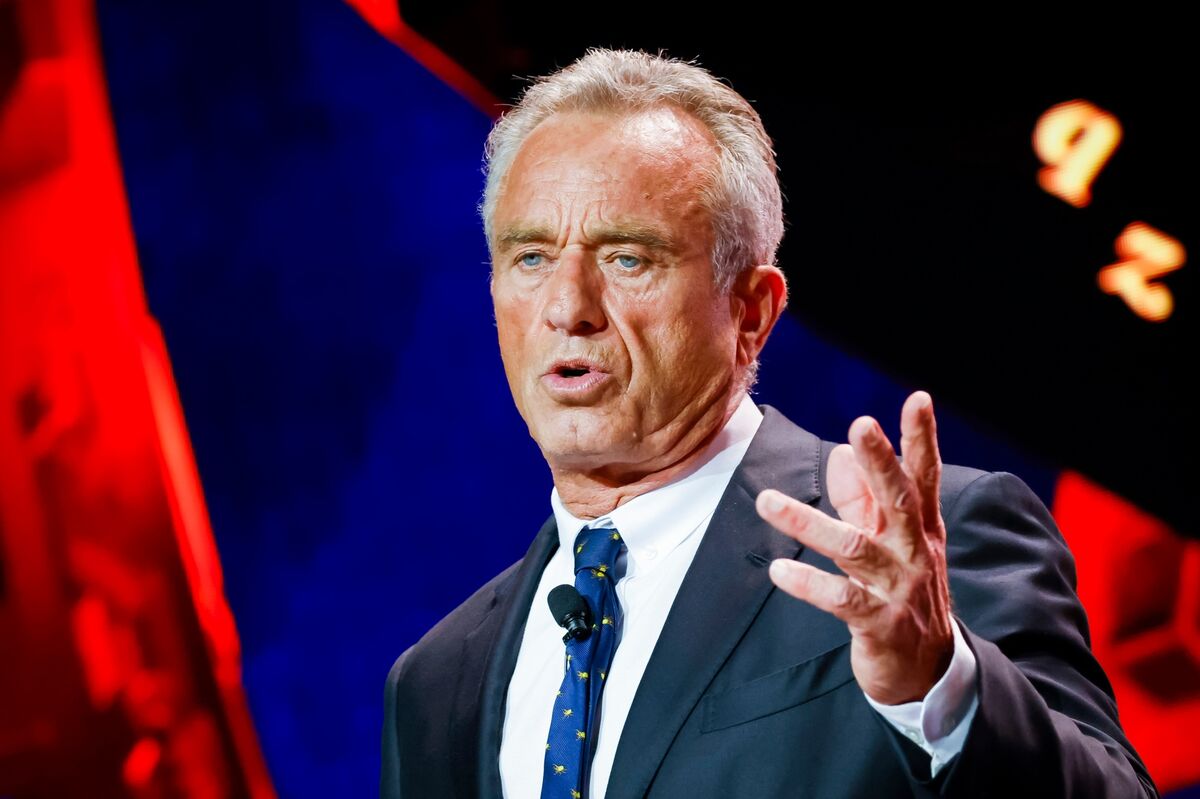
Robert F. Kennedy Jr.
Kennedy gives confirmation of what this writer and most of those who have followed this crime since it happened in the 1960s have long believed. There is no doubt that the CIA was involved in both the execution and the decades-long cover-up. And that may be the principal reason we have never seen all the documents locked away in government vaults. Successive administrations, even after they promise to release information, apparently decide the truth is too damaging to our intelligence community to admit. And while it delays, most of those prominent in researching that historic murder have died, along with those who actually authorized or committed the crime.
As a bit player from the first challenges to the Warren Report in the 1960s, we have intense interest in anything a Kennedy says about the assassination. At the time of JFK’s murder, the Kennedys were notably quiet. Both Robert and Ted Kennedy issued identical statements about the Warren Commission report which concluded that Lee Harvey Oswald was the lone assassin. Both said they had not read the report but had no reason to question its conclusion.
We have since learned that the brothers knew more than they said at the time. Within days of JFK’s murder, Bobby Kennedy through private channels got word to the Soviet Union’s Nikita Krushchev that he knew the Soviets were not involved – that this was a domestic murder. And RFK quietly followed events relating to his brother’s death – such as the highly publicized work of New Orleans district attorney Jim Garrison, who uncovered suspicious individuals linked to the CIA but ultimately resulted in the acquittal of the man he accused of being part of a plot.
There aren’t many people left who were close to the original assassination doubters. We became one accidentally shortly after the Warren Commission Report in 1965. Our colleague at Philadelphia Magazine, Gaeton Fonzi, was contacted by a Philadelphia school board lawyer named Vincent Salandria who was one of the few people who had actually read the 26 volumes of the report.

Vincent Salandria, left, advised Gaeton Fonzi on his mission to get to JFK truth.
We sat in on Fonzi's first meeting with Salandria. A gaunt, unnervingly intense man, he pointed out the glaring inconsistencies in the Warren report regarding the wounds to JFK. He showed how “the single bullet theory” that had been conceived by Philadelphia attorney Arlen Specter, later a U.S. Senator, was impossible. The whole Warren Commission Report hinged on that element.
After presenting his compelling case, Salandria said, “Don’t you see it, boys, don’t you see it? There’s only one outfit who could have pulled this off.”
He meant, of course, the CIA. Fonzi was doubtful about going that far – until he interviewed Arlen Specter – and was shocked that he could not explain his own single bullet theory. Fonzi wrote as much in Philadelphia magazine and followed up with other articles. Fonzi’s Philadelphia work caught the attention of Richard Schweiker, who later as a U.S. Senator was a key figure in reopening the investigation of JFK’s death in the mid-1970s. Schweker hired Fonzi to look into CIA/anti-Castro activity in South Florida. He was convinced that Oswald was more than a lone gunman, saying he “had the fingerprints of intelligence all over him.”
Fonzi by this time was a partner in our Florida Gold Coast Magazine. He took the assignment confident that the assassination would be solved, especially when Richard Sprague, a brilliant and hard-nosed Philadelphia prosecutor, was selected to head the investigative committee. But Sprague quickly ran into trouble when he refused to sign a secrecy agreement with the CIA. He was in fact investigating its connections to Oswald. Right-wing politicians ganged up and forced Sprague to resign. To Fonzi, that was further proof that the CIA had something to hide.
He had already fulfilled Schweiker’s hunch that South Florida might be fertile ground. A prominent Miami anti-Castro leader, Antonio Vecianna, not knowing Fonzi was on the JFK case, casually told him he had seen Oswald in the company of his own CIA handler in Dallas not long before the assassination. Fonzi was stunned and pushed hard to discover that the CIA man, who used the alias Maurice Bishop, was actually David Atlee Phillips, a high-ranking CIA officer who was coordinating people involved in anti-Castro plots.
Despite the importance of his CIA discovery, Fonzi was ordered to spend time checking out possible Mafia involvement, which he could never establish. CIA operatives, notably Frank Sturgis of Watergate fame, made a game of sending him on time-consuming wild goose chases with tantalizing but bogus information that eventually led to CIA tricksters. Fonzi often worked out of our Gold Coast office so we followed his every step over several years.
He was disappointed in the committee’s final report, which he helped write. It did say JFK’s death was a conspiracy but was vague about the nature of the conspiracy. He decided to write a dissenting opinion. “The Last Investigation” first appeared in three installments in Gold Coast Magazine and a cover story in Washingtonian magazine. It detailed his findings about the CIA, including its motive. It represented a deep state that hated Kennedy, considering him a traitor who wanted to lessen tensions with the Soviets and wanted us out of Vietnam. These articles resulted in a lawsuit against the Washingtonian, which it won, but received little press at the time. However, the book has gone through several printings, and the New York Times has called it one of the best books on the assassination.
Fonzi’s work has influenced other researchers over the years. Mentioning all their revelations is too long and complex to appear here, but several government agencies were clearly involved. For starters, the disgraceful Warren Commission was never run by Chief Justice Earl Warren. It was controlled by Allen Dulles, the ex-CIA chief who had been fired by JFK after the Bay of Pigs fiasco. The very man who should have been investigated ran the investigation. He was helped by the FBI, under J. Edgar Hoover, no fan of the Kennedys, whose bureau withheld important information from the Warren Commission, including CIA connections regarding Jack Ruby, the man who murdered Oswald. And even the Secret Service was negligent in taking usual precautions for protecting the president and seemed a partner in the subsequent cover-up. Talk about a wide conspiracy. As Vince Salandria said in 1965, “There’s only one outfit that could have pulled this off.”
There aren’t many of us still around who had early exposure to the important critics of the JFK assassination. Just about all the people mentioned in this essay are gone. But we assume that Robert Kennedy is familiar with all these details and a lot more. Through necessity, the torch has been passed to a new generation. And Robert F. Kennedy Jr. is not a bad torch bearer.
